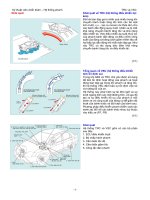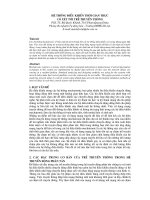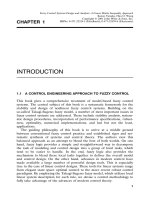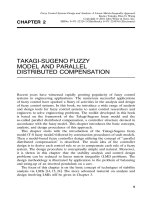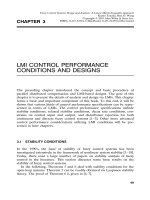Tài liệu Hệ thống điều khiển mờ - Thiết kế và phân tích P10 ppt
Bạn đang xem bản rút gọn của tài liệu. Xem và tải ngay bản đầy đủ của tài liệu tại đây (198.88 KB, 21 trang )
Fuzzy Control Systems Design and Analysis: A Linear Matrix Inequality Approach
Kazuo Tanaka, Hua O. Wang
Copyright ᮊ 2001 John Wiley & Sons, Inc.
Ž. Ž .
ISBNs: 0-471-32324-1 Hardback ; 0-471-22459-6 Electronic
CHAPTER 10
FUZZY DESCRIPTOR SYSTEMS
AND CONTROL
This chapter deals with a fuzzy descriptor system defined by extending the
original Takagi-Sugeno fuzzy model. A number of stability conditions for the
fuzzy descriptor system are derived and represented in terms of LMIs.
A motivating example for using the fuzzy descriptor system instead of the
original Takagi-Sugeno fuzzy model is presented. An LMI-based design
approach is employed to find stabilizing feedback gains and a common
Lyapunov function.
The descriptor system, which differs from a state-space representation, has
generated a great deal of interest in control systems design. The descriptor
system describes a wider class of systems including physical models and
wx
nondynamic constraints 1 . It is well known that the descriptor system is
much tighter than the state-space model for representing real independent
parametric perturbations. There exist a large number of papers on the
stability analysis of the T-S fuzzy systems based on the state-space represen-
tation. In contrast, the definition of a fuzzy descriptor system and its stability
wx wx
analysis have not been discussed until recently 2 . In 2 we introduced the
fuzzy descriptor systems and analyzed the stability of such systems. This
wx
chapter presents both the basic framework of 2, 3 as well as some new
developments on this topic.
Ž.
As mentioned in Chapter 1, h l® / or denotes all the pairs i, k
ik
ŽŽ.. ŽŽ.. Ž.
excepting h z t ® z t s 0 for all z t ; h l h l® / or denotes all
ik ijk
Ž. ŽŽ..ŽŽ.. ŽŽ.. Ž.
the pairs i, j, k excepting h z thz t ® z t s 0 for all z t ; and
ijk
ŽŽ.. ŽŽ.. ŽŽ..
i - j s.t. h l h l® / or denotes all i - j excepting h z thz t ® z t
ijk i j k
Ž.
s 0, ᭙ z t .
195
FUZZY DESCRIPTOR SYSTEMS AND CONTROL
196
10.1 FUZZY DESCRIPTOR SYSTEM
wx
In 4, 5 , a fuzzy descriptor system is defined by extending the T-S fuzzy
Ž. Ž.
model 2.3 and 2.4 . The ordinary Takagi-Sugeno fuzzy model is a special
case of the fuzzy descriptor system. We derive stability conditions for the
fuzzy descriptor system, where the E matrix in the fuzzy descriptor system
is assumed to be not always nonsingular. The fuzzy descriptor system is
defined as
r
e
r
® z t Ext s h z t Ax t q Bu t ,
Ž. Ž. Ž. Ž. Ž.
Ž. Ž.
Ž.
˙
ÝÝ
kk i i i
k
s1 is1
10.1
Ž.
r
y t s h z t Cx t ,
Ž. Ž. Ž.
Ž.
Ý
ii
i
s1
where
x t g R
n
, y t g R
q
, u t g R
m
,
Ž. Ž. Ž.
r
h z t G 0, h z t s 1,
Ž. Ž.
Ž. Ž.
Ý
ii
i
s1
r
e
® z t G 0, ® z t s 1.
Ž. Ž.
Ž. Ž.
Ý
kk
k
s1
Here x g R
n
is the descriptor vector, u g R
m
is the input vector, y g R
q
is
the output vector, E g R
n=n
, A g R
n=n
, B g R
n=m
, and C g R
q=n
. The
kii i
Ž. Ž.
known premise variables zt; ztmay be functions of the states, external
1 p
disturbances, andror time.
wx wx
Remark 32 A fuzzy descriptor system was first defined in 2 . In 2 , a
Ž Ž .. Ž Ž ..
e
wx
special case, that is, h z t s® z t and r s r , was presented. In 4, 5 ,
ik
Ž.
the fuzzy descriptor system was generalized as shown in 10.1 .
Ž. w
T
Ž.
T
Ž.x
T
Ž.
By defining x* t s x t x t , the fuzzy descriptor system 10.1 can
˙
be rewritten as
rr
e
E*x* t s h z t ® z t A* x* t q B*u t ,
Ž. Ž. Ž. Ž. Ž.
Ž.Ž.
Ž.
˙
ÝÝ
ik ik i
i
s1 ks1
10.2
Ž.
r
y t s h z t C*x* t ,
Ž. Ž. Ž.
Ž.
Ý
ii
i
s1
where
0 I
I 0
E* s , A* s ,
ik
A yE
00
ik
0
C 0
B* s , C* s .
i
ii
B
i
Ž.
In the following the stability for the fuzzy descriptor system 10.2 is
considered.
STABILITY CONDITIONS
197
10.2 STABILITY CONDITIONS
Ž.
The open-loop systems of 10.2 is defined as follows:
rr
e
E*x* t s h z t ® z t A* x* t .10.3
Ž. Ž. Ž. Ž. Ž .
Ž.Ž.
˙
ÝÝ
ik ik
i
s1 ks1
Ž.
The fuzzy descriptor system 10.3 is quadratically stable if
dV x* t
Ž.
Ž.
Fy
␣
x* t ,
Ž.
2
dt
where
V x* t s x*
T
t E*
T
Xx* t ,
Ž. Ž. Ž.
Ž.
and the following conditions are satisfied:
rr
e
Ž.
1. det sE* y h z t ® z t A* / 0 and the open-loop system
Ž. Ž.
Ž.Ž.
ÝÝ
ik ik
i
s1 ks1
is impulse free.
2. There exist a common matrix X and
␣
) 0 such that
X g R
2 n=2 n
, E*
T
X s X
T
E* G 0, det X / 0.
Ž.
Theorem 33 gives a sufficient condition for ensuring the stability of 10.3 .
Ž.
THEOREM 33 The fuzzy descriptor system 10.3 is quadratically stable if
there exists a common matrix X such that
E*
T
Xs X
T
E* G 0,10.4
Ž.
A*
T
X q X
T
A* - 0, h l® / or.10.5
Ž.
ik ik i k
Proof. Consider a candidate of the quadratic function
V x* t s x*
T
t E*
T
Xx* t .
Ž. Ž. Ž.
Ž.
Then,
rr
e
U T U
TT
˙
V x* t s h z t ® z t x* t AXq XA x* t .
Ž. Ž. Ž. Ž. Ž.
Ž. Ž.Ž.
Ž.
ÝÝ
i k ik ik
i
s1 ks1
Therefore, we have the following stability conditions:
A*
T
X q X
T
A* - 0, h l® / or. Q.E.D.
Ž.
ik ik i k
FUZZY DESCRIPTOR SYSTEMS AND CONTROL
198
Ž.
Remark 33 As mentioned before, h l® / or denotes ‘‘all the pairs i, k
ik
ŽŽ.. ŽŽ.. Ž.
excepting h z t ® z t s 0 for all z t .’’ In other words, we can ignore the
ik
Ž . Ž . Ž Ž .. Ž Ž .. Ž .
condition 10.5 for the pairs i, k such that h z t ® z t s 0 for all z t .
ik
Remark 34 In Theorem 33, X is not required to be positive definite.
Corollary 5 is needed to discuss the stability of closed-loop systems.
Ž. Ž. Ž. Ž.
COROLLARY 5 The conditions 10.6 and 10.7 imply 10.4 and 10.5 ,
where S is a positi®e definite matrix:
1
S s S
T
) 0,10.6
Ž.
11
TT
ASq SA )
i 33i
- 0, h l® / or,10.7
Ž.
ik
TT
S q SAy ES yESy SE
11ik3 k 11k
Ž.
where the asterisk denotes the transposed elements matrices for symmetric
Ž. Ž
T
.
T
positions. For example, in 10.7 , it represents S q SAy ES .
11ik3
Proof. Define X as
S 0
1
X s .
SS
31
Ž. Ž.
Then, 10.6 is obtained from 10.4 as follows:
I 0 S 0 S 0
11
T
E* X ssG0,
00 SS 00
31
TT T
SS I0 S 0
13 1
T
XE* ssG0.
T
0 S 00 0 0
1
Ž.
Equation 10.7 is obtained as follows:
A*
T
X q X
T
A*
ik ik
TTT
0 AS0 SS 0 I
i 113
sq
TT
I yESS 0 SAyE
k 31 1 ik
TT TT
ASq SA Sq ASy SE
i 33i 1 i 13k
s - 0. Q.E.D.
Ž.
TT
S q SAy ES yESy SE
11ik3 k 11k
STABILITY CONDITIONS
199
Remark 35 It is stated in Remark 34 that X is not required to be posi-
tive definite. However, in Corollary 5, X is assumed to be invertible since
S 0
1
X s , where S ) 0.
1
SS
31
Next, we consider stability conditions for closed-loop systems. We propose
Ž. Ž.
a modified PDC 10.8 to stabilize the fuzzy descriptor system 10.2 :
rr
e
u t sy h z t ® z t F* x* t ,10.8
Ž. Ž. Ž. Ž. Ž .
Ž.Ž.
ÝÝ
ik ik
i
s1 ks1
F 0
where F* s . The fuzzy controller design problem is to determine
ik
ik
the local feedback gains F .
ik
Ž. Ž.
By substituting 10.8 into 10.2 , the fuzzy control system is represented as
rrr
e
E*x* t s h z thz t ® z t A* y B*F* x* t .
Ž. Ž. Ž. Ž. Ž.
Ž.Ž.Ž.
˙
Ž.
ÝÝÝ
ijk ikijk
i
s1 js1 ks1
10.9
Ž.
Ž.
Theorem 34 gives a sufficient condition for ensuring the stability of 10.9 .
Ž.
THEOREM 34 The fuzzy descriptor system 10.2 can be stabilized ®ia the
Ž.
PDC fuzzy controller 10.8 if there exist Z , Z , and M such that
13 ik
Z
T
s Z ) 0, 10.10
Ž.
11
T
yZ y Z )
33
Z q AZ
- 0,
1 i 1
T
yZE y EZ
1 kk1
ž/
yBM q EZ
iik k3
h l® / or, 10.11
Ž.
ik
T
y2 Z y 2 Z )
33
2 Z q AZ
1 i 1
F 0,
T
yBM q AZ
y2 ZE y 2 EZ
ijk j1
1 kk1
0
yBM q 2 EZ
jik k3
i - j F r s.t. h l h l® / or, 10.12
Ž.
ijk
Ž.
where the asterisk denotes the transposed elements matrices for symmetric
positions.
FUZZY DESCRIPTOR SYSTEMS AND CONTROL
200
Proof. Consider a candidate of a quadratic function
V x* t s x*
T
t E*
T
Xx* t ,
Ž. Ž. Ž.
Ž.
where
S 0
1
X s .
SS
31
Then,
rrr
e
T
˙
V x* t s h z thz t ® z t x* t
Ž. Ž. Ž. Ž. Ž.
Ž . Ž.Ž.Ž.
ÝÝÝ
ijk
i
s1 js1 ks1
=
T
T
A* y B*F* X q XA* y B*F* x* t
Ž.
Ž.Ž.
½5
ik i jk ik i jk
rr
e
2 T
s h z t ® z t x* t
Ž. Ž. Ž.
Ž.Ž.
ÝÝ
ik
i
s1 ks1
=
T
T
A* y B*F* X q XA* y B*F* x* t
Ž.Ž.Ž.
Ä4
ik i ik ik i ik
rr
e
T
q 2 h z thz t ® z t x* t
Ž. Ž. Ž. Ž.
Ž.Ž.Ž.
ÝÝÝ
ijk
i
s1 i-jks1
=
T
A* y B*F* q A* y B*F*
ik i jk jk j ik
X
½
ž/
2
A* y B*F* q A* y B*F*
ik i jk jk j ik
T
qXx* t .
Ž.
5
ž/
2
Therefore, the stability conditions are derived as follows:
E*
T
Xs X
T
E* G 0, 10.13
Ž.
G
T
X q X
T
G - 0, h l® / or, 10.14
Ž.
iik iik i k
T
G q GGq G
ijk jik ijk jik
T
X q X F 0,
ž/ž/
22
i - j F r s.t. h l h l® / or, 10.15
Ž.
ijk
where
0 I
G s A* y B*F* s ,
ijk ik i jk
A y BF yE
iijk k
F 0
F* s .
ik
ik
STABILITY CONDITIONS
201
Ž.
Equation 10.13 can be rewritten as
X
yT
E*
T
s E*X
y1
G 0.
The above inequality is
yT y1
S 0 I 0 I 0 S 0
11
sG0.
SS 00 00 SS
31 31
Therefore, we obtain
TT
Z yZI0
13
T
0 Z 00
1
I 0 Z 0 Z 0
11
ssG0,
00 yZZ 00
31
where
Z s S
y1
and Z s S
y1
SS
y1
.
11 3131
Note that the following relation holds:
S 0 Z 0 I 0
11
s .
SS yZZ 0 I
31 31
Ž.
Equation 10.14 can be rewritten as
X
yT
G
T
XX
y1
q X
yT
X
T
GX
y1
iik iik
TT TTT
Z yZ 0 A y FB
13 iiki
s
TT
0 ZI yE
1 k
Z 0
0 I
1
q
A y BF yE
yZZ
iiik k
31
T
yZ y Z )
33
Z q AZ
s - 0.
1 i 1
T
yZE y EZ
1 kk1
ž/
yBM q EZ
iik k3
Ž. Ž.
Equation 10.12 is also derived in the same way as condition 10.11 .
Ž.
Q.E.D.
FUZZY DESCRIPTOR SYSTEMS AND CONTROL
202
Ž
The fuzzy controller design problem is to determine F i s 1,2, ...,r;
ik
e
.
k s 1,2, . . . , r satisfying the conditions of Theorem 34. The feedback gains
are obtained as
F s MZ
y1
ik ik 1
S 0
1
from the solution Z and M of the above LMIs. The matrix X s is
1 ik
SS
31
obtained as S s Z
y1
and S s Z
y1
ZZ
y1
.
11 3131
Ž. ŽŽ..
Next, we derive stability conditions for 10.9 in the case of h z t s
i
ŽŽ..
e
Ž.
® z t and r s r . In this case, the fuzzy descriptor system 10.2 can be
k
rewritten as
r
E*x* t s h z t A* x* t q B*u t , 10.16
Ž. Ž. Ž. Ž. Ž .
Ž.
Ž.
˙
Ý
iii i
i
s1
where
I 00I
E* s , A* s ,
ii
00 A yE
ii
0
B* s .
i
B
i
Ž. Ž.
In this case, the PDC controller 10.17 instead of 10.8 is used:
r
u t sy h z t F*x* t , 10.17
Ž. Ž. Ž. Ž .
Ž.
Ý
iii
i
s1
w F 0 x
where F* s . In this case, Theorem 34 can be simplified as follows.
i
ii
ŽŽ.. ŽŽ..
e
THEOREM 35 Assume that h z t s® z t and r s r . Then, the fuzzy
ik
Ž. Ž.
descriptor system 10.16 can be stabilized ®ia the PDC fuzzy controller 10.17 if
there exist Z , Z , and M such that
13 i
Z
T
s Z ) 0, 10.18
Ž.
11
T
yZ y Z )
33
Z q AZ
- 0,
1 i 1
T
yZE y EZ
1 ii1
ž/
yBMq EZ
ii i3
i s 1,2,...,r , 10.19
Ž.
